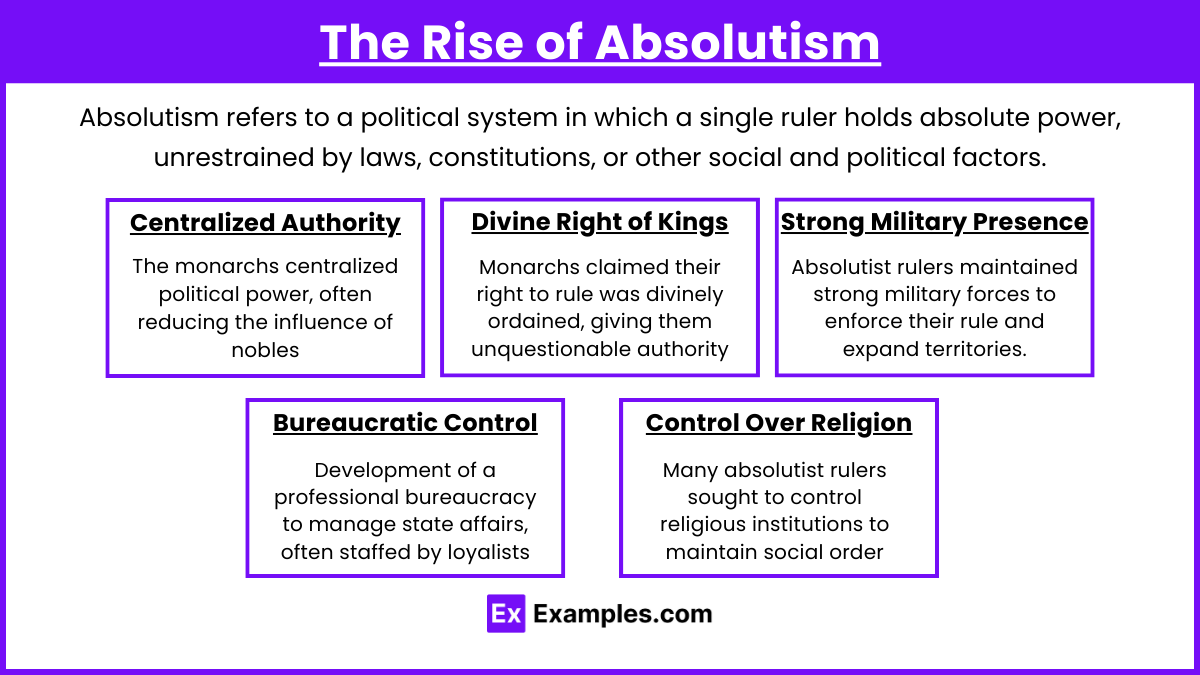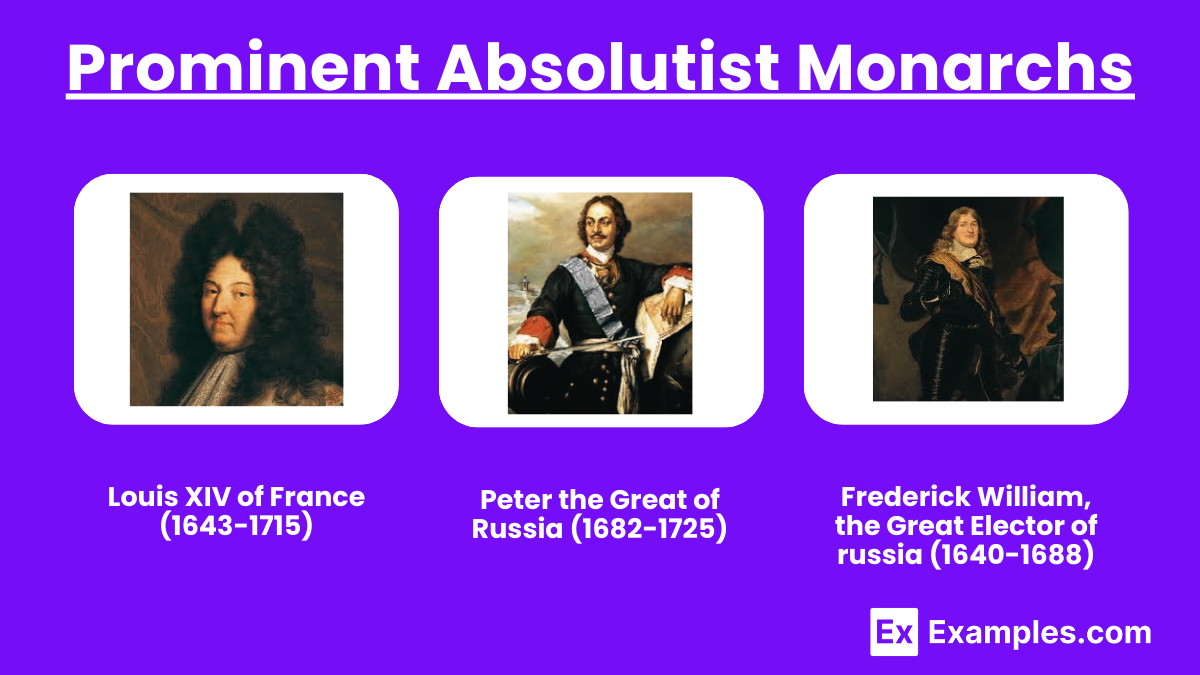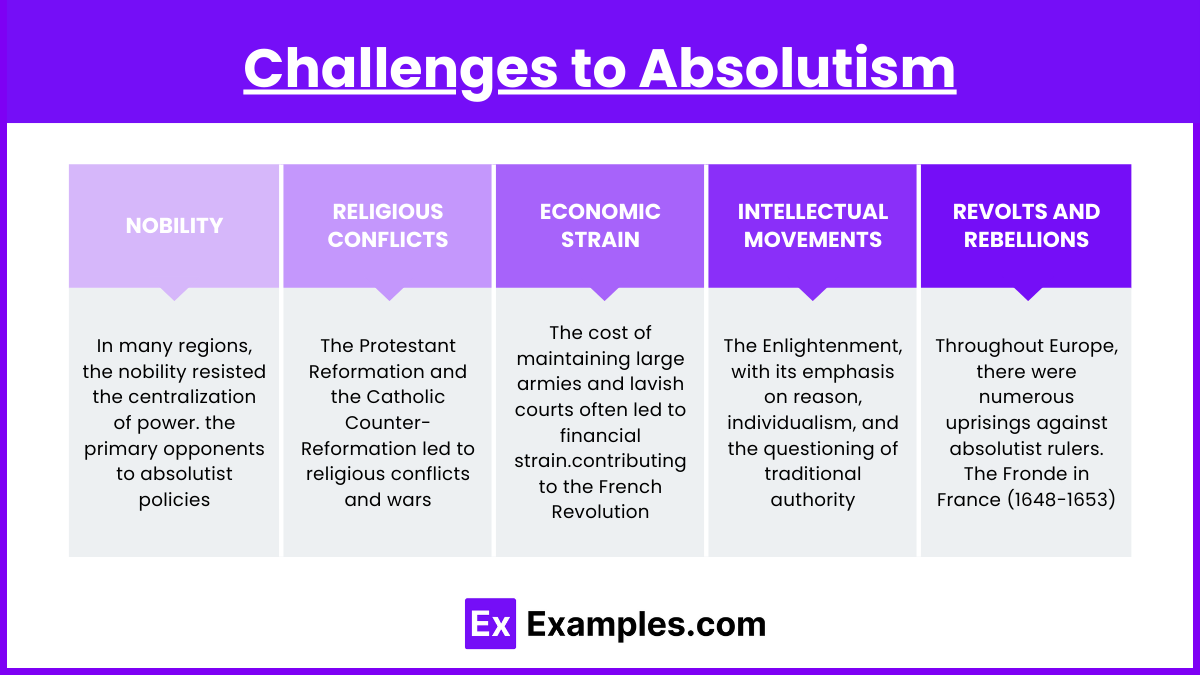The rise of absolutism in Europe during the 17th and 18th centuries marked a significant shift in political power, as monarchs centralized authority, reducing the influence of nobility and parliaments. This era saw rulers like Louis XIV and Peter the Great asserting control through the doctrine of divine right and expanding bureaucracies. However, absolutism faced challenges from religious conflicts, economic strains, and intellectual movements like the Enlightenment, which advocated for constitutional governance and individual rights, leading to significant political transformations.
Learning Objectives
The Rise of Absolutism and Challenges to It in AP European History include understanding the political, economic, and social factors that led to the rise of absolutist monarchies in Europe. Students should grasp key characteristics of absolutism, analyze the policies and impacts of notable rulers like Louis XIV and Peter the Great, and evaluate the intellectual, religious, and political challenges to absolutism. Additionally, students should explore the emergence of alternative governance models, such as constitutionalism, and the broader European power dynamics during this period.
The Rise of Absolutism

Absolutism refers to a political system in which a single ruler holds absolute power, unrestrained by laws, constitutions, or other social and political factors. This period, primarily from the 16th to the 18th centuries in Europe, saw the consolidation of royal power, where monarchs asserted their authority over states and territories. The belief was that kings ruled by divine right, a doctrine that claimed their authority was sanctioned by God. This form of governance is characterized by several key features:
Key Characteristics of Absolutism
- Centralized Authority: The monarchs centralized political power, often reducing the influence of nobles and other political bodies.
- Divine Right of Kings: Monarchs claimed their right to rule was divinely ordained, giving them unquestionable authority.
- Strong Military Presence: Absolutist rulers maintained strong military forces to enforce their rule and expand territories.
- Bureaucratic Control: Development of a professional bureaucracy to manage state affairs, often staffed by loyalists rather than nobles.
- Control Over Religion: Many absolutist rulers sought to control religious institutions to maintain social order and justify their power.
Prominent Absolutist Monarchs

- Louis XIV of France (1643-1715): Known as the “Sun King,” Louis XIV epitomized absolutism with his famous phrase, “L’État, c’est moi” (I am the state). He centralized the French government, weakened the power of the nobility, and built the opulent Palace of Versailles as a symbol of his power.
- Peter the Great of Russia (1682-1725): Peter the Great modernized Russia, expanding its territory and transforming it into a major European power. He established a strong navy, reformed the army, and centralized the government.
- Frederick William, the Great Elector of Brandenburg-Prussia (1640-1688): He strengthened the military, centralized the administration, and laid the groundwork for the future Kingdom of Prussia.
Challenges to Absolutism

Despite the seeming dominance of absolutist rulers, there were significant challenges to their authority:
- Nobility: In many regions, the nobility resisted the centralization of power. They were often the primary opponents to absolutist policies, as they stood to lose significant influence and privileges.
- Religious Conflicts: The Protestant Reformation and the Catholic Counter-Reformation led to religious conflicts and wars, such as the Thirty Years’ War (1618-1648). These conflicts often challenged the authority of absolutist rulers who tried to impose religious uniformity.
- Economic Strain: The cost of maintaining large armies and lavish courts often led to financial strain. In France, for example, the heavy taxation needed to support the state’s expenditures led to widespread discontent, contributing to the French Revolution.
- Intellectual Movements: The Enlightenment, with its emphasis on reason, individualism, and the questioning of traditional authority, provided intellectual challenges to absolutism. Philosophers like John Locke and Montesquieu argued for the separation of powers and the rights of individuals, laying the groundwork for modern democratic thought.
- Revolts and Rebellions: Throughout Europe, there were numerous uprisings against absolutist rulers. The Fronde in France (1648-1653), the English Civil War (1642-1651), and various peasant revolts exemplified the widespread discontent with absolute rule.
The Decline of Absolutism
By the late 18th century, the ideals of absolutism began to decline, giving way to more constitutional forms of governance. Key events that marked this transition include:
- The Glorious Revolution (1688): In England, the Glorious Revolution led to the establishment of a constitutional monarchy, limiting the power of the monarch and laying the foundation for parliamentary democracy.
- The American Revolution (1775-1783): The American Revolution challenged the concept of monarchical rule and emphasized ideas of liberty and democracy.
- The French Revolution (1789-1799): The French Revolution dramatically overthrew the absolutist regime in France, leading to the rise of republican ideals and the decline of monarchies across Europe.
The rise of absolutism in Europe was a significant historical phenomenon characterized by centralized power and divine right monarchies. However, this period also saw numerous challenges and eventual decline due to economic, social, and intellectual factors. Understanding these dynamics is crucial for grasping the evolution of modern political systems and the transition towards democratic governance.
Examples of The Rise of Absolutism and Challenges to it
- France under Louis XIV
- Rise: Centralized power, weakened nobility, declared “L’état, c’est moi.”
- Challenges: Financial strain, Huguenot unrest after Revocation of Edict of Nantes.
- Spain under Philip II
- Rise: Centralized power, enforced Catholic orthodoxy, strengthened the navy.
- Challenges: Financial bankruptcy, defeat of the Spanish Armada, Dutch resistance.
- Russia under Peter the Great
- Rise: Modernized Russia, reduced nobility’s power, reformed the church.
- Challenges: Resistance from traditionalists, streltsy revolts.
- Prussia under Frederick the Great
- Rise: Military reforms, centralized control, religious tolerance.
- Challenges: Opposition from nobility, strain from frequent wars.
- England under Charles I
- Rise: Attempted absolute rule, dissolved Parliament, imposed taxes unilaterally.
- Challenges: English Civil War, opposition led to his execution, rise of the Commonwealth.
Practice Test Questions on The Rise of Absolutism and Challenges to it
Question 1: Which of the following best describes the concept of Absolutism?
A) A form of government where the power is divided among different branches.
B) A political system in which a single ruler holds all the power and authority, often justified by divine right.
C) A democratic system where the power is held by the people through elected representatives.
D) A form of government where the military holds the majority of control.
Answer: B) A political system in which a single ruler holds all the power and authority, often justified by divine right.
Explanation:
Absolutism is a form of governance where a single monarch or ruler has complete and unrestricted control over the government and the people. This power is often claimed to be given by divine right, suggesting that the ruler is chosen by God and is, therefore, above the law. Unlike systems that separate powers or allow for checks and balances, absolutism centralizes power in the hands of one individual.
Question 2: Which of the following was a significant challenge to absolutism during the early modern period?
A) The Industrial Revolution
B) The Enlightenment
C) The establishment of the United Nations
D) The fall of the Roman Empire
Answer: B) The Enlightenment
Explanation:
The Enlightenment was a significant intellectual and cultural movement in the 17th and 18th centuries that emphasized reason, individualism, and skepticism of traditional authority. Thinkers like John Locke and Montesquieu challenged the notion of absolute monarchy, advocating for ideas such as separation of powers, natural rights, and government by consent of the governed. These ideas inspired movements towards more democratic forms of governance and posed a direct challenge to the legitimacy of absolute monarchs.
Question 3: Which European country is most famously associated with the absolute monarchy of Louis XIV?
A) England
B) Spain
C) France
D) Russia
Answer: C) France
Explanation:
Louis XIV of France, also known as the “Sun King,” is one of the most well-known absolute monarchs in history. His reign from 1643 to 1715 is often cited as the epitome of absolutist rule. Louis XIV centralized power in the French state, built the Palace of Versailles as a symbol of his absolute control, and famously declared “L’état, c’est moi” (“I am the state”), illustrating the complete fusion of the monarchy with the state. France under Louis XIV became a model of absolutist governance in Europe.


